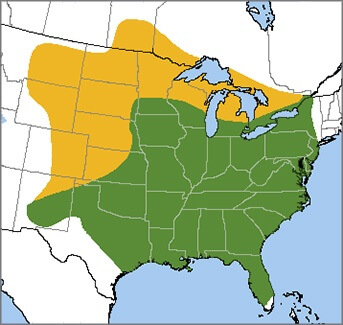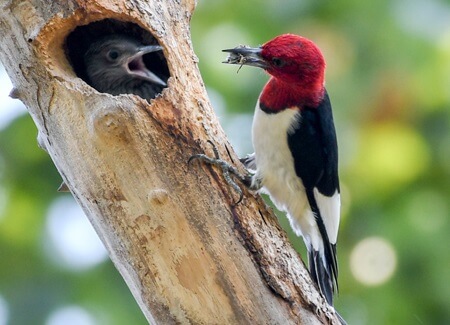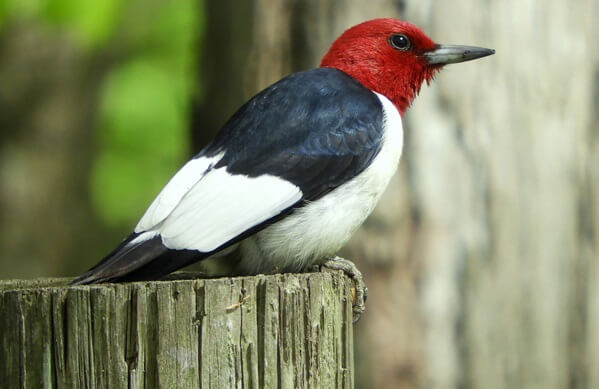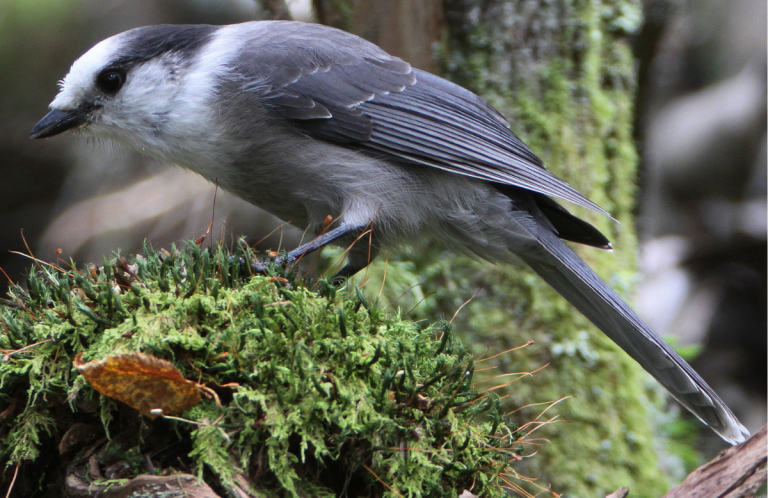
Map: Gold represents breeding range; green represents year-round range.
The Red-headed Woodpecker is a charismatic and colorful species, recognizable to even the most casual birder. Its eye-catching plumage gives this woodpecker a number of whimsical nicknames, including flag bird, flying checker-board, jellycoat, patriotic bird, and shirt-tail bird. They are noisy as well as colorful, vocalizing with a variety of harsh “churrs” and rising “queery” calls.
This woodpecker's preferred habitat — open groves with abundant snags for nesting and roosting — puts it in direct competition with introduced cavity-nesting birds such as European Starlings. But the main driver of Red-headed Woodpecker declines is habitat loss caused by development of bottomland forest and suppression of fires found naturally in some forest ecosystems.
Similar population declines have been noted in other species that prefer open woods and glades, including Prairie Warbler, Flammulated Owl, and Olive-sided Flycatcher.
Nomadic Nut Lovers
Red-headed Woodpeckers can be found throughout the central and eastern United States and southern Canada, in places where the habitat is right. It is a nomadic species, with periodic movements influenced by the yearly abundance of nuts, a favored winter food, rather than time of year. As the range map shows, some northern populations of Red-headed Woodpecker migrate south in the fall, but many populations remain in one place year-round, especially if acorns, beechnuts, and other nut crops are abundant.
Saving a Stash
The Red-headed Woodpecker is one of only four woodpecker species that commonly stores or “caches” food. (The others include Acorn, Downy, and Red-bellied Woodpeckers.) The birds can be observed stuffing nuts and other edible items in crevices, tree cavities, or under bark. These caches provide the woodpecker with a reliable source of food year-round.
Red-headed Woodpeckers are more omnivorous than many woodpeckers, feeding on a wide variety of insects and other invertebrates, fruits, berries, and seeds, as well as nuts. They also feed in a variety of ways. Although Red-headed Woodpeckers drill into dead wood in typical woodpecker fashion, they will also pluck prey from vegetation or the ground. Also, like Lewis's Woodpecker, the Red-headed Woodpecker is an accomplished catcher of flies, darting out from a stationary perch to capture insects in mid-air.

Red-headed Woodpecker feeding young by Brent Barnes, Shutterstock
Colorful Cavity Nester
Like Eastern Bluebird, the Red-headed Woodpecker is a cavity nester, dependent on snags and dead and dying tree limbs for nests as well as food sources. Mated birds may excavate their own cavity or use an existing one.
Pairs may remain together for several years and often use the same nest cavity each year as well. In the south of their range, Red-headed Woodpeckers may even raise two broods a year.
Male and female Red-headed Woodpeckers look alike, but juveniles can be told by the coloring of their heads, which are a dull grayish-brown rather than the bright red of adult birds. The young birds gradually molt into full color by their second year but can show an odd patchwork of gray, brown, and red plumage on their heads in the meantime.
Sign up for ABC's eNews to learn how you can help protect birds
Managing Habitat for Red-headed Woodpeckers
Partners in Flight lists the Red-headed Woodpecker as a Watch List Species for the United States and Canada due to steep population declines and threats to its habitat.
American Bird Conservancy participates in several management programs that benefit this species. The Central Hardwoods Joint Venture (CHJV), of which ABC is a partner, is restoring large acreages of natural communities like open oak and oak-pine woodlands using thinning and prescribed fire — favored habitats of this woodpecker.
"The Red-headed Woodpecker is the poster child of savanna-woodland systems," says Jane Fitzgerald, CHJV Coordinator at ABC. "It's critically important that the public support the kind of management — such as thinning and prescribed fire on ecologically-appropriate sites — needed to restore healthy populations on both public and private lands."
ABC also works with the Sustainable Forestry Initiative to facilitate forest management that benefits Red-headed Woodpeckers and many other species, including Golden-winged Warbler and Swallow-tailed Kite.
Donate to support ABC's conservation mission!



















































